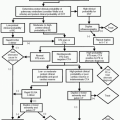Diverticulitis
Michael W. D’Angelo
Etiology.
Diverticulosis is the most common colonic disease of Western society. It is seen in approximately 40-50% of people older than 50 years and approximately 80% of people older than 85 years. A diverticulum is an acquired herniation of mucosa through the muscularis layer of bowel.
Diverticulitis is a complication seen in 10-20% of patients with diverticulosis. It occurs when an inspissated piece of fecal material collects within and obstructs the lumen of a diverticulum. The vascular supply to the wall of the diverticulum becomes compromised and renders the diverticular wall susceptible to invasion by colonic bacteria. Obstruction and/or perforation of a diverticulum create a local inflammatory response which dissects into the adjacent pericolic fat causing a localized phlegmon or a discrete abscess, and occasionally generalized peritonitis.
Location.
Diverticulitis most commonly affects the sigmoid colon, which is also the most common location of diverticulosis (the location of highest intraluminal pressure). Diverticula can be seen anywhere in the bowel except the rectum.
Symptoms and Signs.
Potential symptoms and signs include fever, chills, leukocytosis, left lower quadrant colicky pain and tenderness, palpable mass, altered bowel habits, and local signs of peritoneal irritation.
Differential Diagnosis.
Any process causing acute left lower quadrant pain can mimic diverticulitis. Differential diagnosis includes colon cancer, inflammatory bowel disease, radiation colitis, ischemic colitis, pseudomembranous colitis, appendicitis, epiploic appendagitis, ectopic pregnancy, ovarian torsion, endometriosis, salpingitis, ureteral colic, intestinal obstruction, psoas abscess, and leaking aortic aneurysm.
Stay updated, free articles. Join our Telegram channel

Full access? Get Clinical Tree



